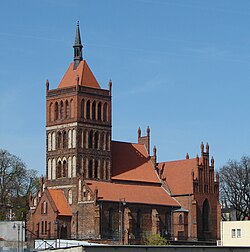Chełmża
| Chełmża | ||
|---|---|---|

Saint Nicholas Church, built XIII-XIV century.
|
||
|
||
| Coordinates: 53°11′5″N 18°36′15″E / 53.18472°N 18.60417°ECoordinates: 53°11′5″N 18°36′15″E / 53.18472°N 18.60417°E | ||
| Country |
|
|
| Voivodeship | Kuyavian-Pomeranian | |
| County | Toruń | |
| Gmina | Chełmża (urban gmina) | |
| Area | ||
| • Total | 7.84 km2 (3.03 sq mi) | |
| Population (2006) | ||
| • Total | 15,273 | |
| • Density | 1,900/km2 (5,000/sq mi) | |
| Postal code | 87-140 | |
| Website | http://www.chelmza.pl | |
Chełmża [ˈxɛu̯mʐa] (German: Kulmsee, earlier Culmsee), is a town in Toruń County, Kuyavian-Pomeranian Voivodeship, Poland. It is located at around 53°11′5″N 18°36′15″E / 53.18472°N 18.60417°E.
The first signs of settlement date to 10,000 BC when reindeer hunters made their visits to the area. Around 4500 BC the first agricultural settlements were founded.Goth tribes also moved through the area on their trek from Scandinavia and North Germany. Visible signs of existence of the Old Prussians also exist. Around the 7th century Slavs (Goplans) arrived in the area.
In the time of first Piasts and the formation of Poland, Ziemia Chełmińska and the settlement of Łoza (now the town of Chełmża) was incorporated into Chełmińska castellany. After the death of Bolesław Krzywousty in 1138 it was handed over to his son Bolesław IV Kędzierzawy – as part of Masovia. The fights with nearby Old Prussian tribes resulted in several raids that destroyed the area. In the 13th century the ruler of the area was Konrad I Mazowiecki who in order to Christianize the Old Prussians brought a missionary Christian bishop. The bishop was granted a number of possession including the settlement of Łoza. Later Teutonic Knights were granted local lands to support the bishop by military means. However, in time the knights took over the possession of Christian, dividing the area into four dioceses in 1243, including the Chełmińska diocese. At the end of 1245 Heidenreich (Heidenryk) of the Bishopric of Culm became the bishop of diocese. He picked Łoza as place of his stay. It was during that time that Łoza received its new name Culmense and became part of the residence of the bishop who resided and governed in Warmia from 1245 to 1263. In 1251 (before July 22) Bishop Heidenreich bestowed city rights to Łoza and renamed it Culmsee (Kulmsee). A number of other towns are mentioned in his territory as well, such as Hermannysdorp, Arnoldisdorp, Sconenwerde, Belacin, Razlai, Zcampe, Heiminsod and Vambresin or Wambresin.
...
Wikipedia


